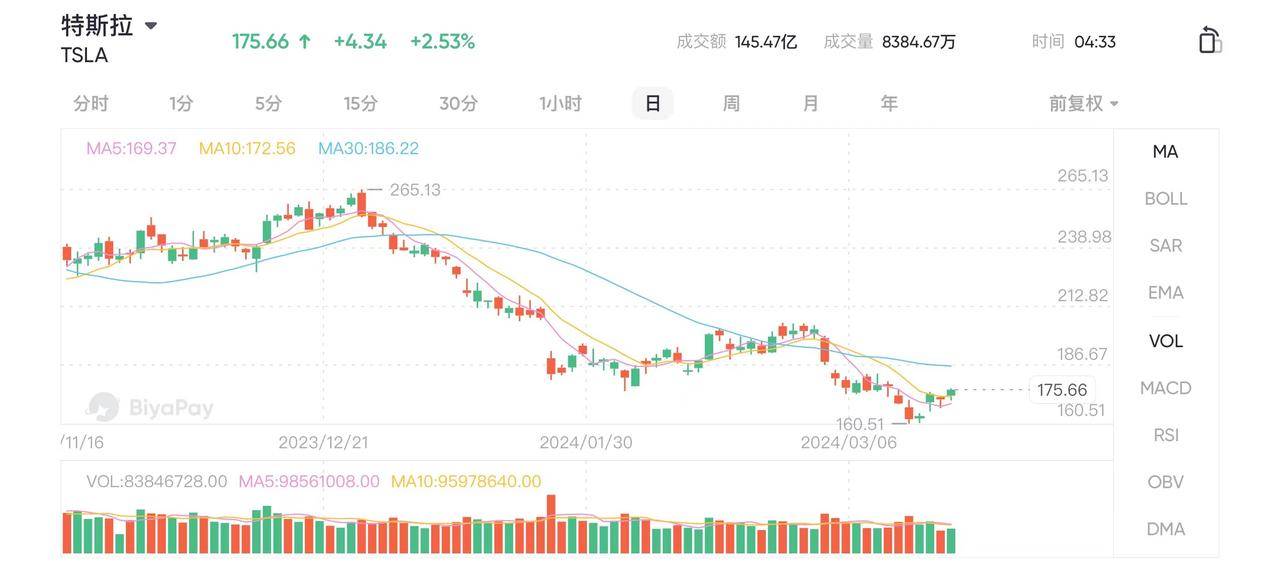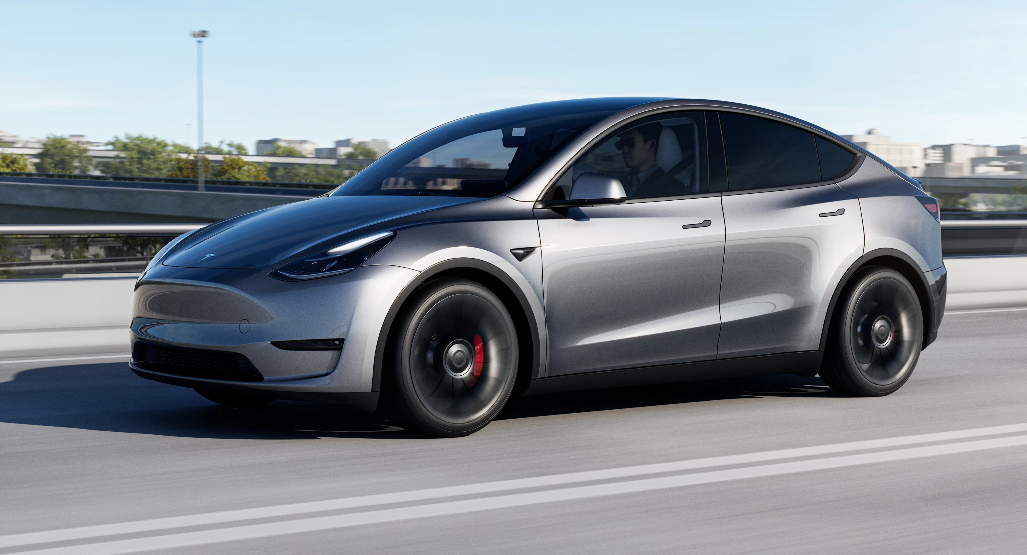- Remittance
- Exchange Rate
- Stock
- Events
- EasyCard
- More
- Download
- 6th Ann

What Happened? Tesla Drops Nearly 60% from Its Peak: Where Will the Stock Go from Here?
Since entering 2024, Tesla’s stock price has become the focus of the US stock market.

Tesla’s recent trend, source: BiyaPay App
Initially, in January, Tesla’s stock price plummeted for 4 weeks, with a decline of up to 26%! In February, Tesla’s stock price rebounded to some extent, rising about 10%; starting in March, Tesla fell into a sharp decline again, with a maximum drop of about 19%.
This time, the overall stock market rose again. However, this time, Tesla (TSLA) stock still did not lead the gains. So far this year, Tesla’s stock price has fallen by 34%, while the Nasdaq 100 index continues to rise. Tesla’s stock price has fallen nearly 60% from its historical high, while the broader market is close to its historical high.
Why did Tesla’s stock price plummet?
As the leader of the new energy vehicle industry in the United States, Tesla’s strength is beyond doubt, and Musk also topped the list of the world’s richest people due to the surge in Tesla’s stock price.
Now, Tesla’s stock is at another crossroads. Bulls may argue that this is an excellent buying opportunity, as the company is preparing for the next round of growth. Bears, however, believe that the company is finally moving towards a normal valuation. Which view is correct? Are electric vehicle stocks worth buying now? What will happen to Tesla’s stock in three years?
1.Wall Street Shorts Tesla
Shorting Tesla has become a consensus among investors in the United States.
Shorting is a special investment method, its core is that the stock quantity remains unchanged despite price changes.
The principle of shorting, for example: You own 10 shares of this company, and I now borrow these 10 shares from you, agreeing to return 10 shares to you after half a year, your shareholding remains the same; but now, after borrowing 10 shares, I sell them at a market price of 20 dollars/share. Half a year later, if the company’s stock falls to 15 dollars/share, I will buy 10 shares back at the market price of 15 dollars/share and return them to you, and you still own 10 shares of the company.
However, in this process, I buy 10 shares at 15 dollars/share and sell them at 20 dollars/share, making a profit of 5 dollars/share, totaling a profit of 50 dollars over six months. Additionally, while borrowing the 10 shares from you, I will also pay you some interest based on the market price.
This is the process of shorting.
In summary, after shorting begins, the more the stock price of the shorted company falls, the more the short seller earns.
From the time Tesla’s stock price soared to about 400 dollars/share and Musk became the world’s richest person, Wall Street had already set its sights on Tesla.
At the beginning of 2022, financial institutions that publicly announced shorting Tesla included Citron Research, Muddy Waters, Kynikos Associates, Chanos & Company, J.P. Morgan, and so on, each a giant of Wall Street.
However, these institutions suffered heavy losses in the first round of shorting in 2021. It was not until 2022, when the Federal Reserve started the interest rate hike cycle and the US stock market plummeted, that Tesla was also hit hard, and Wall Street institutions turned the tide.
In 2024, two more well-known institutions publicly shorted Tesla, namely Wells Fargo and UBS. On March 14, these two banks downgraded Tesla’s rating to neutral, while labeling Tesla as a “growth company without growth.”
On the same day, several well-known US media reported that Tesla cars had become the fastest-depreciating cars in America. That day, Tesla’s stock price plummeted by 4.2%.
Looking directly at Tesla’s stock price trend, Tesla’s stock has been plummeting since the second half of 2022 and 2023, making a fortune for institutions shorting Tesla!
Perhaps you might wonder, isn’t Tesla part of Wall Street?
Actually, it is not.
Wall Street is a concept, referring to the American financial capital group, which is very large, with many powerful entities within its system, each with its own merits. Even among these giants, there is competition for interests. Companies like Apple, Qualcomm, and Amazon, which started in the 1980s and rose to prominence, indeed have deep ties with Wall Street, but Tesla is an exception.
Since its listing, Tesla had been losing money until 2018, suffering losses for over a decade. Wall Street did not truly take such long-term loss-making companies seriously, hence the investment amount was also less.
Tesla’s rise was after it built a factory and started sales in Shanghai, China, with its performance turning profitable in 2019. Coupled with the impact of the pandemic in 2020, the Federal Reserve initiated an unlimited quantitative easing (QE) policy and started printing money extensively, which sent Tesla’s stock price soaring to levels that shocked Wall Street.
Therefore, we see a Tesla that stands apart from Wall Street, a Musk who does not fit in with the American financial capital group.
Moreover, there is competition within Wall Street, and even more so with a new energy vehicle company. As long as shorting Tesla is profitable, they will rush in.
2.Decrease in Profit Margins and Production
Tesla’s strategy centers around volume growth and strong profit margins to justify its capacity expansion. When Tesla’s profit margins were high, this argument made sense. However, now Tesla’s operating profit margin for the past 12 months has fallen below 10%, at its lowest level in over two years. Similar to its profit margins, Tesla’s stock price has also seen a decline.
In its investor report for the fourth quarter of 2023, Tesla stated, “In 2024, our vehicle growth rate may be significantly lower than in 2023, as our team is launching the next generation of vehicles at Gigafactory Texas.”
2023 was more acceptable because Tesla’s sales growth was incredible. But by 2024, oil production growth seems to be stagnating, and further price reductions may cause profit margins to decline further. Since Tesla began mass-producing the Model 3, 2024 will be the first year of real deceleration in growth for Tesla. This situation will put significant pressure on Tesla’s stock in the short term.

3.Tesla’s Stock Is Currently Not Overvalued
Despite such pressures, Tesla’s long-term investment thesis remains intact.
The automotive industry is cyclical, and balancing factory expansion and new product innovation on top of this inherent cyclicality is no easy feat. Whether Tesla can maintain its footing amid increasingly fierce competition will be the real test in the coming years.
The biggest problem for Tesla is not its slowing growth, but its valuation. Analysts generally expect Tesla’s earnings per share in 2024 to be $3.05, and $4.16 in 2025. For context, Tesla’s diluted earnings per share reached a record $4.31 in 2023.
Tesla’s price-to-earnings (P/E) ratio is 40.8, pricing it like a growth stock. Understandably, the P/E ratio is based on Tesla’s earnings over the past 12 months, currently at its record earnings for 2023.
However, since Tesla’s earnings are expected to decline this year, even if the stock price remains unchanged, the P/E ratio will rise. This is why Tesla’s forward P/E ratio is 55.7 times, far higher than its historical P/E ratio, making it the company with the highest expected P/E ratio among the “Magnificent Seven,” even higher than NVIDIA!
Tesla no longer deserves such a high valuation. The P/E ratio could be between 30 - 35, definitely higher than the S&P 500’s 27.8 times. But faced with so much competition, compared to other faster-growing brands, Tesla’s risk/reward ratio does not seem high.
Can Tesla’s new car launch turn things around?
To attract more customers, Tesla might need to introduce a more affordable car. Even though Tesla continues to lower the prices of new Model 3 and Y vehicles worldwide, only a certain number of cars can be sold. There are not many people on this planet who can afford expensive electric cars.
To expand its potential customer base, Tesla plans to launch cheaper new cars in the coming years.
There are rumors that it plans to do so sometime in 2025. This does not guarantee that the new product will be launched in 2025. Launching new car models will definitely help Tesla boost sales.
However, if the new model’s price is around $25,000, with the average selling price of Tesla cars continually decreasing, Tesla’s revenue growth will lag behind its sales growth.
Tesla’s Stock Is Still Not Cheap
Smart investors know that a stock’s current earnings are not important; what matters is its earnings in a few years. When forecasting Tesla’s stock trend in the next few years, we need to estimate its financial trajectory. Assuming Tesla’s profit margin remains at 9.2% as in 2023, Tesla could earn $17.8 billion in three years by doubling its 2023 revenue to $194 billion.
Currently, using the multi-asset trading wallet BiyaPay tool, Tesla’s market capitalization is seen at $559.4 billion. Dividing by $17.8 billion, the P/E ratio is 31, slightly higher than the market average. If you want to buy on dips, you must be more optimistic about Tesla’s future growth, and use BiyaPay to search its code for real-time online trading. You can also deposit digital currency (USDT) into BiyaPay, then withdraw fiat to invest in US stocks.
In fact, Tesla has a clear way to turn things around. Its balance sheet is strong enough to withstand an industry downturn. It can absorb profit compression better than its peers. If other companies cut back on electric vehicle spending, Tesla could capture more market share. Over time, Tesla might also prove to be more resilient in competition. Finally, it may start monetizing some long-term robotics and artificial intelligence projects, achieve breakthroughs in full automation driving, or experience some other unexpected developments.
In conclusion, Tesla appears to be more worth holding now. But if valuations decline or business unexpectedly improves, then Tesla might be worth a closer look.
Lastly, investors should consider their own risk tolerance and investment objectives when making investment decisions, make reasonable asset allocations, maintain independent thinking, and avoid blindly following trends.

























